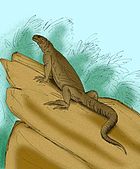Hyporhina
| Hyporhina Temporal range: Late Eocene − Middle Oligocene,
| |
|---|---|
| Scientific classification | |
| Domain: | Eukaryota |
| Kingdom: | Animalia |
| Phylum: | Chordata |
| Class: | Reptilia |
| Order: | Squamata |
| Family: | Rhineuridae |
| Genus: | †Hyporhina Baur, 1893 |
| Species | |
Hyporhina is an extinct genus of amphisbaenians or worm lizards that lived from the Late Eocene to the Middle Oligocene (approximately 40 to 30 million years ago) in what is now the western United States.
Species
It currently includes two species, both from the White River Formation in eastern Wyoming and northeastern Colorado:
- Hyporhina antiqua — the type species.
- Hyporhina galbreathi
- Hyporhina tertia — a third species named in 1972, and later synonymized with Hyporhina galbreathi.
Taxonomy
Paleontologist Georg Baur named the genus Hyporhina in 1893, making it one of the first prehistoric amphisbaenians to be described. Baur placed it in its own family, Hyporhinidae, because it possessed eye sockets that are enclosed at the back by postorbital bars, a feature that living amphisbaenians lack.
However, more recent studies have placed it within Rhineuridae, a family that includes the living Rhineura floridana from Florida, and many more extinct species from the western United States that were named after 1893 and have postorbital bars. Hyporhina differs from other rhineurids in having a steep angle to its snout.[1]
See also
References
- ^ Hembree, D.I. (2007). "Phylogenetic revision of Rhineuridae (Reptilia: Squamata: Amphisbaenia) from the Eocene to Miocene of North America". The University of Kansas Paleontological Contributions. 15: 1–20.
- Amphisbaenians
- Paleogene lizards
- Eocene lepidosaurs
- Oligocene lepidosaurs
- White River Fauna
- Eocene reptiles of North America
- Paleogene reptiles of North America
- Lizard genera
- Prehistoric reptile genera
- Eocene United States
- Eocene genus first appearances
- Oligocene genus extinctions
- Fossil taxa described in 1893
- Taxa named by Georg Baur
- Prehistoric lizard stubs





